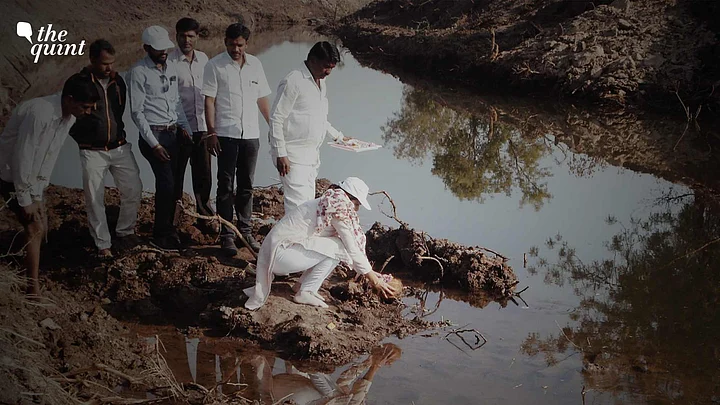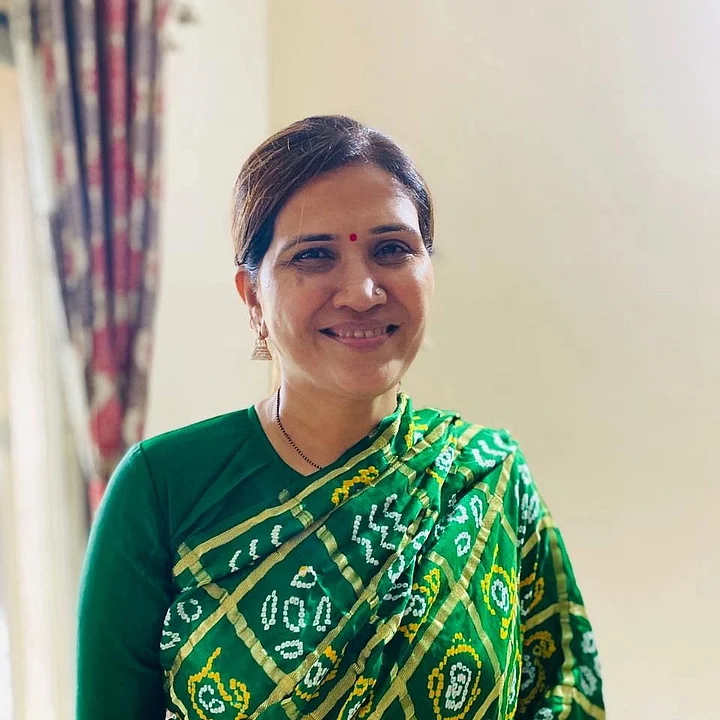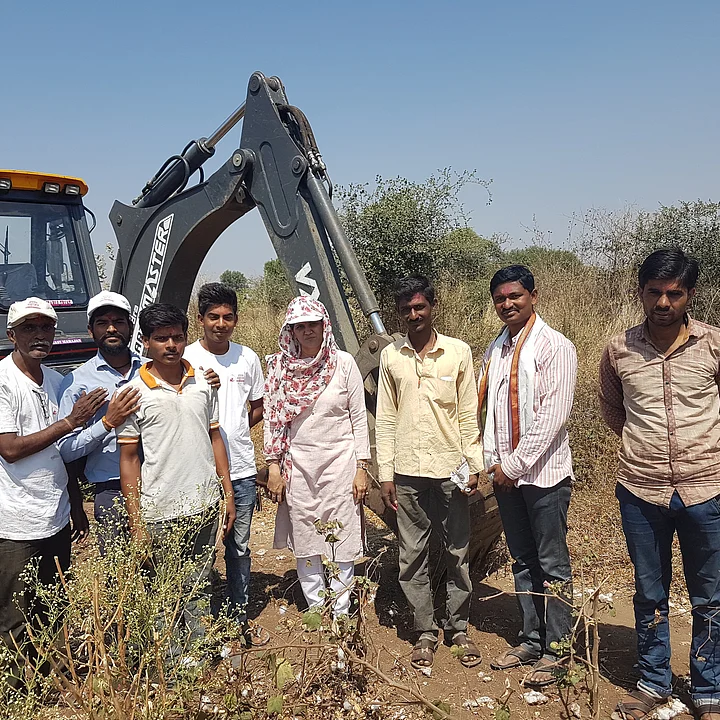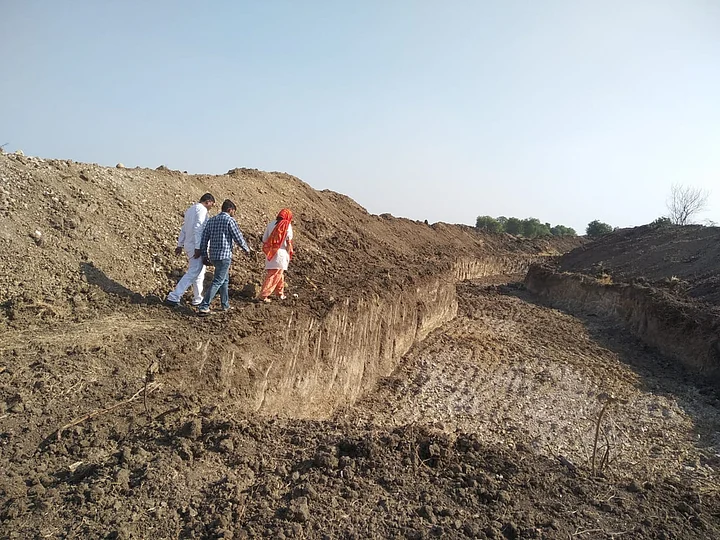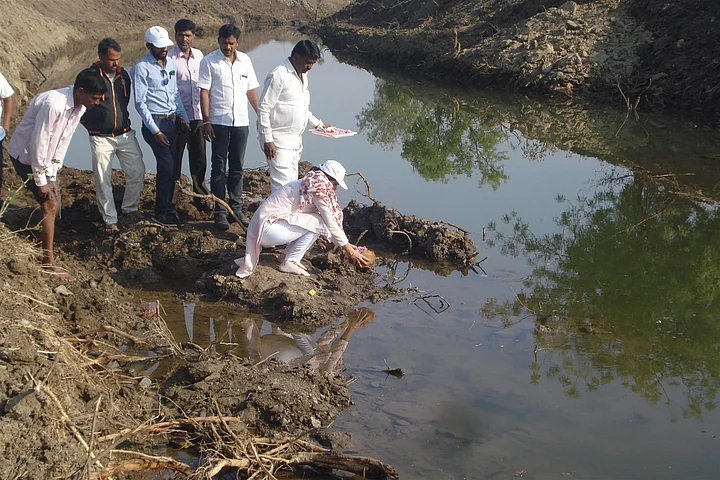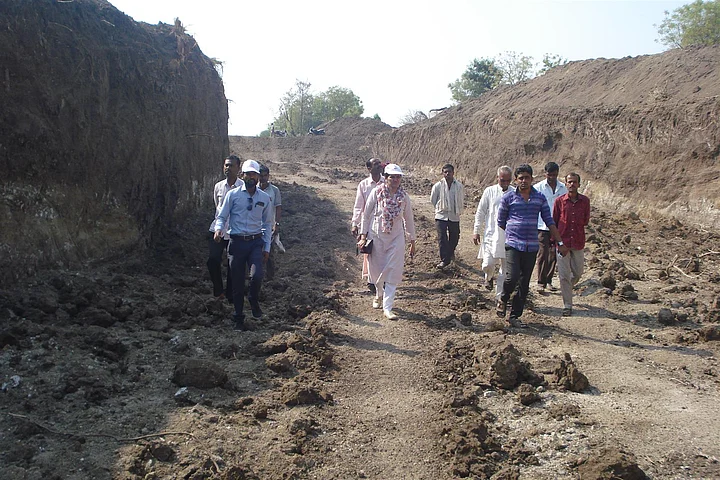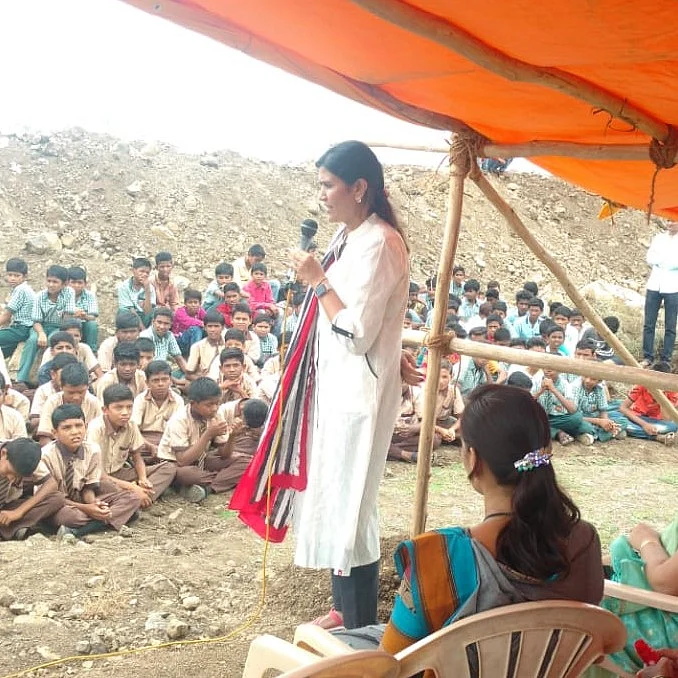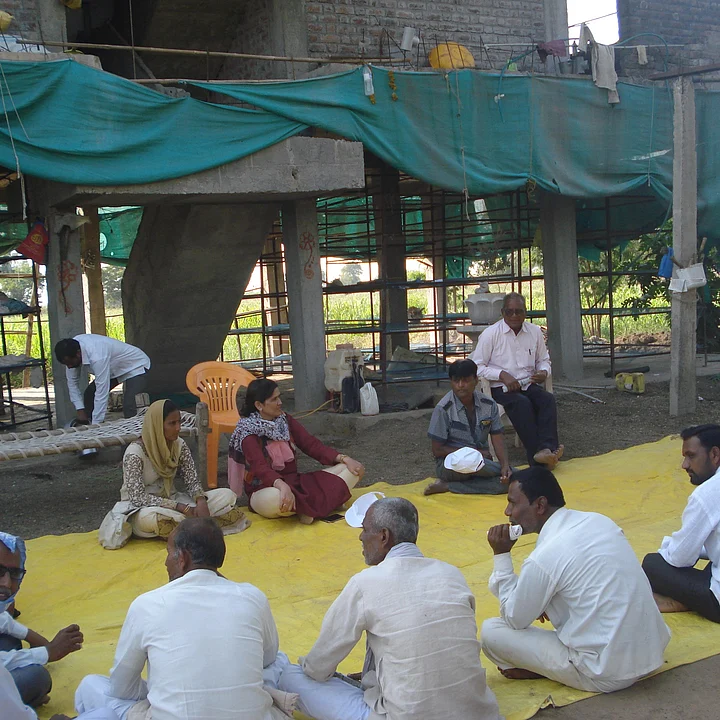It was in the aftermath of the drought in the state of Maharashtra during 2013-2016, the worst to hit in 40 years, that a fundamental shift took place in the mind of Nutan Upendra Desai aka Niutanben, now 51.
In June 2016, when she found herself in remote Ambajogai in Beed district to oversee her team’s water rejuvenation work and witnessed for herself what she thought existed only in films right before her eyes - parched, dry cracked brown earth, emaciated and undernourished men, women, children and cattle dying from the lack of water and sometimes succumbing to water-borne diseases due to the quality of water they were consuming - her life changed in some ways forever.
That humans could consume and drink what she was hesitant to touch: dirty fungus-filled green water with black molecules floating was a shock to her eyes and system. A basic human right, something millions of us take for granted, was being denied to these people and she for one could not live with the unfairness of it. The families were surviving on a rationed quantity of 200 liters of this filthy water for 7-8 days per family and were absurdly grateful for it. It was beyond comprehension for someone who had never witnessed or suffered such scarcity in her life and she knew she had no option but to vest herself more fully in this.
- 01/02
51-year-old Nutan Upendra Desai aka Niutanben.
- 02/02
Niutanben with her team.

After she completed her work in 48 villages in Beed, Nutanben made her way to Jalna in July-August 2016, where she began working on desilting water bodies and rejuvenating water sources in partnership with the local communities. Her Ahmedabad-headquartered NGO Samasth Mahajan through its partnership with the A.T.E Chandra foundation (A.T.E CF) in Mumbai provided the rental costs of the expensive machines required for the job while the locals contributed their bit by providing the diesel. Her team worked to make sure it translated into results on the ground.
Although her NGO - she is the executive trustee based out of Mumbai - had been set up many years ago with the purpose of focussing on animal care, it had in fact primarily focussed on saving and improving human lives in a country prone to natural and manmade calamities and government intervention often inadequate or even absent. Human beings at some level took precedence.
Jalna’s Transformation: From 250 Tankers A Day to Nil
When Nutanben and her team began work in around 330-odd villages and taluka that comprise the Jalna district, the situation was not much better than in Beed. Water was very scarce, most of the water bodies in the region were silted up or bone dry and tankers were a way of life. At the time they started working, each tehsil - there are 8 in Jalna district - survived on 250 tankers per day. Farmers were barely producing anything since there was no water for farming; meeting basic consumption needs was a struggle.
Moreover, when the team arrived in the district, villagers and locals were highly skeptical about whether such work could be done with community participation and through the efforts of an NGO. “It was primarily seen as work only the government could do”, explains Narayan Devkate, 55, a farmer in Pimparkhed, who tends to his 50-acre land parcel with his two brothers. Of the 117-odd villages in his vicinity, 78 had no water at all when the effort began, he adds.
Painstakingly and with gentle but persistent persuasion, the work began and ranged from desilting and rejuvenating small ponds, recharging borewells, naali kholikaran (veins of the river that have got filled with silt and turned dry), and compartment bunding. As a result, a total of 427 km of naalas have been opened, 19 ponds have been brought back to life and a total of 797443 cubic meters of silt has been removed and carted in the last 6-7 years.
Over the last four years, work has started on cleaning and rejuvenating the 20 km Kundalika and Seena rivers, of which around 5 km has been done so far and a total of 900,000 lakh cubic meters of silt and a total of 405,000 cubic meters of garbage has been pulled out and carted! To see the river flowing even if only in part gives Nutanben and her team a spark of joy that few other things manage!
But what is perhaps only joy and satisfaction for the NGO team working on the ground translates to a far better quality of life for the area’s farmers and community. Laxman Sawade was growing around five quintals of cotton every year on his seven-acre farm and barely managing to make ends meet. In 2013, he took the initiative of applying 300 trollies of silt on three acres. Not only has his cotton output gone up, he is also growing grapes on his land since. Overall, his income has jumped to Rs 15 lakh a year, helping him build a better home, and buy 2.5 additional acres of land, a tractor, and a motorbike.
Overall, the notion that almost nothing brings more prosperity and hope than water security has been amply reinforced by the 330-odd villages that comprise Jalna. Devkate says that three new factories have come up in the area including a water-intensive sugarcane factory, leading to new employment opportunities in the district. In a region that has been bereft of almost any work opportunities, this, he argues, is what has helped bring in more and more takers for the ongoing efforts.
Making PPP Work: Samast Mahajan, A.T.E Chandra Foundation, and More
For all those lamenting the failure of public and private partnerships in India, the water rejuvenation efforts of Maharashtra offer a beacon of hope. It was in 2013 that Bain Capital chairman Amit Chandra - who set up and finances the A.T.E Chandra foundation - and his wife Archana started questioning why despite a lot of talk and bluster, farmer suicides in drought-hit Maharashtra refused to abate and it didn’t take rocket science to reach a quick answer: poor rainfall = failed crop season = farmer debt = farmer suicide.
That’s when they came across Nimesh Sumati of Caring Friends, an NGO already working on the simple model they have since adopted: silt removal and rejuvenation of water bodies. Primary research done by them showed that there are many water bodies across the country that have over the years become defunct or unable to hold much water due to heavy silting. The groundwater too fails to get recharged as the silt prevents the rainwater from reaching the bottom.
But if someone removed the silt, the water body could be rejuvenated and even better the silt - which is usually quite fertile - could be used by farmers on their land to improve productivity.
- 01/03
Niutanben working on the field with her team.
- 02/03

- 03/03

From 2016 to 2019, A.T.E CF along with 22-odd partner organizations worked extensively in Maharashtra on rejuvenation of water bodies at scale to rejuvenate over 2,700 water bodies, impacting around 4,200 villages. COVID dampened but did not stop the efforts and in 2020 and 2021, work continued in Rajasthan and Karnataka. In 2022, the work picked up pace once again and 916 water bodies were rejuvenated in 18 districts of Maharashtra, Rajasthan, Uttar Pradesh, and Madhya Pradesh, some at the behest of Niti Aayog which had by then been pulled in by the foundation.
Niti Aayog Buys In
It was in 2021-22 that the A.T.E CF team decided to approach Niti Aayog which quickly bought into the scheme. In June 2018, Niti Aayog brought out a report on the “Composite Water Management Index”, which mentions that India is undergoing the worst water crisis in its history and nearly 600 million people are facing high to extreme water stress. The report further mentions that India is placed at 120th amongst 122 countries in the water quality index, with nearly 70% of water being contaminated.
The model presented by the foundation to the Niti Aayog could be scaled very quickly at a fraction of the cost to unleash water security in drought-prone regions. It was community-led with farmers bearing a portion of the cost and aligns almost perfectly with the Amrit Sarovar mission launched by the Prime Minister in April 2022 where the plan is to rejuvenate and develop 75 water bodies in each and every district of the country.
The traditional approach of building new water bodies, dams, and canals is more expensive, ecologically, and environmentally damaging and often leads to large-scale displacement of people in the area.
As a result, in the last two years, 500 water bodies were rejuvenated with financial support from NITI Aayog. Currently, pilot projects are ongoing in Jharkhand, MP, Rajasthan, and Maharashtra, with a view to extending this to all its aspirational districts and regions that are water stressed.
Maharashtra Goes All Out
Over the last 50 years, droughts and floods in Maharashtra have risen sevenfold and sixfold respectively. It was after the latest devastating droughts faced by the state in 2013-2016 that the state intensified its efforts on making defunct water bodies functional. A senior Maharashtra state government official says that drought has been one of the state’s greatest nemesis in the last decade or so that he has been posted and based there.
The state government rejuvenated over 5,000 water bodies across the state between 2017-2019, mostly through the GDGS (Gaalmukt Dharan, Gaalmukt Shivar) Scheme. At this time, donors were providing the rental charges for the machines for silt removal, the state paid for the diesel, and the farmers for the carting of silt.
But more recently, faced with the threat of El Nino and erratic rain patterns, the state decided it couldn’t wait for donors or other philanthropic funding and that it would fund the full effort on its own steam for now. In April 2023, Rs 2000 crore was allocated to revive the scheme over the next five years, and over 100 NGOs were pulled in to assist. It is expected to lead to the excavation of around 44 crore cubic meters of silt and create an additional surface capacity of 44K crore liters of water. In addition, a subsidy of Rs 15,000 has been provided for small farmers for the first time, to ensure that the silt can be used by them as well as the bigger farmers who can afford to cart it.
Two Hands to Clap
Readers may well ask what the civil society contribution is in cases where the entire funding is provided by the government. And the answer is: it takes both hands to clap. “As has been seen time and again, the projects that work best are those where the private and public sectors come together”, says a former NITI Aayog official. He says that the private or civil society players bring efficiencies and levels of competence that government players often lack. Chandra echoes this sentiment in reverse by saying that the scale government can provide, no private sector player can match.
So even while the state government is willing to finance almost the entire effort, the A.T.E Chandra foundation identifies, monitors, and assists the NGOs that work on the ground.
It has also lent its technology app to the Maharashtra government to collect real-time data on all the water rejuvenation sites across the state from the Mantralaya in Mumbai and to prioritize where such work needs to commence right away. In addition, the foundation also provides regular weekly training for the nodal government officers with the use of the app and any glitches that may arise.
- 01/03
Niutanben addressing a session.
- 02/03
- 03/03
Besides setting up a project management unit, the foundation’s chief operating officer (COO) Gayatri Nair Lobo has made 24 field trips to six states - Madhya Pradesh, Maharashtra, Rajasthan, Uttar Pradesh, Jharkhand, and Karnataka since April 2022 alone! In a country as vast, diverse, and complex as India, very little can be achieved from glass and chrome edifices in Mumbai or Delhi!
Meanwhile, Nutanben and her 8-10 member team remain resolutely focussed on their work which they estimate will need another 2-3 years before it becomes self-sustaining. She knows her frequent trips from Mumbai to Aurangabad and then onwards by road into the nooks and crannies of the innumerable tiny and big villages of Jalna and Palghar will not be ending anytime in a hurry. With her filial responsibilities less intense than in the past, she can afford to focus on ameliorating the water woes she first encountered when she landed in Beed seven years ago. In terms of gratification, anything she achieves in Mumbai pales in comparison.
(Photos: Samasth Mahajan)
(Anjuli Bhargava is a senior writer and columnist based in Goa. This is an opinion article and the views expressed are the author's own. The Quint neither endorses nor is responsible for them.)
